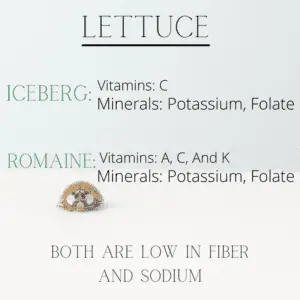


iceberg lettuce is a bit different Romaine takes on more of a bitter flavor, while iceberg has a mild sweetness to it. But the taste and nutrition of romaine vs. "Fifty percent of Americans don’t eat enough fiber, nor do we consume recommended amounts of potassium, calcium, and magnesium, minerals that are found in, you guessed it, leafy greens and lettuce," she says. They’re both used in a wide range of recipes, both being super crunchy, and they both supply a lot of water. For this reason, leaf lettuce is generally.

Dont look for a 'head' on them because the leaves branch from a single stalk. In North America, romaine is often sold as whole heads or as hearts that have had the outer leaves removed and. No matter what you choose, each kind comes packed with antioxidants, water, fiber, and essential nutrients - stuff most us could eat a lot more of. There are three types of leaf lettuce: red, green, and oak. Unlike most lettuces, it is tolerant of heat. "For example, spinach is higher in iron than kale, but kale provides glucosinolates, compounds that may decrease your risk of certain cancers." "Different types of lettuce have varying levels of specific nutrients," explains Jaclyn London, MS, RD, CDN, Nutrition Director at the Good Housekeeping Institute. Iceberg lettuce is medium to large in size, averaging 25-30 centimeters in diameter, and is spherical in shape, similar to cabbage. You add lettuce to sandwiches and sides every day, but staring down the options at the salad bar may have you wondering if one type of leaf beats out the rest - and is there really a difference if a recipe calls for Boston instead Bibb?īotanically speaking, the plant Lactuca sativa includes few basic types, like leaf lettuce, romaine, iceberg, and butterhead, but you'll want to mix other popular greens into your dishes for the biggest nutritional boost.


 0 kommentar(er)
0 kommentar(er)
